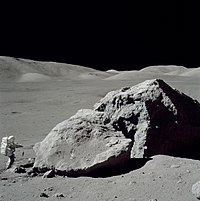Exploration of the Moon
You must add a |reason= parameter to this Cleanup template – replace it with {{Cleanup|May 2006|reason=<Fill reason here>}}, or remove the Cleanup template.

The first leap in Lunar observation was caused by the invention of the telescope. Especially Galileo Galilei made good use of this new instrument and observed mountains and craters on the Moon's surface.
The space race
The Cold War-inspired space race between the Soviet Union and the United States of America led to an acceleration. What was the next big step depends on the political viewpoint: In the US (and the West in general) the landing of the first humans on the moon in 1969 is seen as a culmination, indeed of the space race in general. On the other hand, many scientifically important steps, such as the first photographs of the until then unseen far side of the moon in 1959, were first achieved by the Soviet Union.


The first man-made object to reach the Moon was the unmanned Soviet probe Luna 2, which made a hard landing on September 14, 1959, at 21:02:24 Z. The far side of the Moon was first photographed on October 7, 1959 by the Soviet probe Luna 3. Luna 9 was the first probe to soft land on the Moon and transmit pictures from the Lunar surface on February 3, 1966. It was proven that a lunar lander would not sink into a thick layer of dust, as had been feared. The first artificial satellite of the Moon was the Soviet probe Luna 10 (launched March 31, 1966). The first robot lunar rover to land on the Moon was the Soviet vessel Lunokhod 1 on November 17 1970 as part of the Lunokhod program. One of the main impediments to human exploration of the Moon was development of adequate heat shield technology to permit atmospheric re-entry without completely burning up a manned spacecraft. The USA gained early supremacy in this field through NASA research in thermogravimetric experiments in hypersonic wind tunnels.
On December 24, 1968, the crew of Apollo 8, Frank Borman, James Lovell, and William Anders became the first human beings to see the far side of the Moon with their own eyes (as opposed to seeing it on a photograph). Humans first landed on the Moon on July 20, 1969. The first man to walk on the lunar surface was Neil Armstrong, commander of the American mission Apollo 11. The last man to stand on the Moon was Eugene Cernan, who as part of the mission Apollo 17 walked on the Moon in December 1972. See also: A full list of lunar Apollo astronauts.
Moon rock samples were brought back to Earth by three Luna missions (Luna 16, 20, and 24) and the Apollo missions 11 through 17 (excepting Apollo 13, which aborted its planned lunar landing).
From the mid-1960's to the mid-1970's there were 65 moon landings (with 10 in 1971 alone), but after Luna 24 in 1976 they suddenly stopped. The Soviet Union started focusing on Venus and space stations and the US on Mars and beyond.
Recent exploration
In 1990 Japan visited the moon with the Hiten spacecraft, becoming the third country to orbit the moon. The spacecraft released the Hagormo probe into lunar orbit, but the transmitter failed, thereby preventing further scientific use of the mission.
NASA launched the Clementine mission in 1994, and Lunar Prospector in 1998.
The European Space Agency launched a small, low-cost lunar orbital probe called SMART 1 on September 27, 2003. SMART 1's primary goal was to take three-dimensional X-ray and infrared imagery of the lunar surface. SMART 1 entered lunar orbit on November 15 2004 and continued to make observations until September 3, 2006, when it was intentionally crashed into the lunar surface in order to study the impact plume.[1]
Future plans
On January 14 2004, US President George W. Bush announced the Vision for Space Exploration, a plan leading to new manned lunar missions by 2020. NASA's plan to accomplish that goal was announced on March 19 2005,[2] and was promptly dubbed "Apollo 2.0" by critics. A preliminary unmanned mission, the Lunar Reconnaissance Orbiter, is scheduled for launch in 2008. LRO will take high resolution imagery of the moon's surface and will carry the Lunar Crater Observation and Sensing Satellite (LCROSS), which will investigate the possible existence of water in Shackleton crater.
The People's Republic of China has expressed ambitious plans for exploring the Moon and is investigating the prospect of lunar mining, specifically looking for the isotope helium-3 for use as an energy source on Earth.[3] China has planned an unmanned orbiter in 2010 and has entered into an agreement to work with Russia to eventually land astronauts on the moon before 2020.[4]
Japan has several planned lunar missions, with unmanned Selene in 2007 and LUNAR-A in 2010. Japanese Space Agency (JAXA) plans a manned lunar landing around 2030 that would lead to a manned lunar base by 2030; however, there is no budget yet for this project.[5]
India expects to launch Chandrayaan, an unmanned lunar orbiter, by 2008.
See also
- Project Apollo article provides details of the manned lunar exploration with links to each individual Apollo mission.
- List of unmanned lunar missions
- List of landings on the Moon
- List of artificial objects on the Moon
References
- ^ "ESA's Moon mission ends successfully". ESA. 2006. Retrieved 2006-09-03.
{{cite web}}: Text "titleSMART-1 Impacts Moon" ignored (help) - ^ "How We'll Get Back to the Moon". NASA. Retrieved 2006-03-20.
- ^ David, Leonard (2003). "China Outlines its Lunar Ambitions". Space.com. Retrieved 2006-03-20.
{{cite web}}: Unknown parameter|month=ignored (help) - ^ AP (2006). "Russia-China plan for moon mission". CNN.com. Retrieved 2006-09-16.
{{cite web}}: Unknown parameter|month=ignored (help) - ^ New Scientist staff and AFP (2006). "Japan aims for Moon base by 2030". New Scientist. Retrieved 2006-09-16.
{{cite web}}: Unknown parameter|month=ignored (help)
